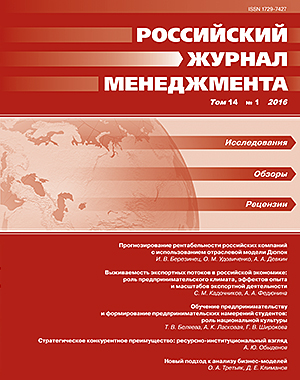Prediction of Profitability of Russian Companies: The Industry-Adjusted DuPont Model
DOI:
https://doi.org/10.21638/spbu18.2016.101Abstract
The article is devoted to the prediction of return on assets of Russian companies. In particular, we analyse whether the use of industry-adjusted DuPont model will improve the quality of forecasting. With a view to discriminate between financial and operational performance the forecasting was carried out for the return on net operating assets. The methodology of the research is based on econometric modelling with the decomposition of profitability with industry-adjusted DuPont model. The industry-adjusted model, in addition to the traditional decomposition of return on assets of the company into profit margin (PM) and asset turnover (ATO), allows for the decomposition into industry-specific component and pure company-specific component. The study was conducted on the sample of 518 Russian companies from eight industries. The total number of observations was 5019 firm-years. We identified the main patterns in the behaviour of industry-adjusted PM and ATO. These results could be used in the assessment of the investment perspectives of the companies, as well as in value-based management techniques.
Keywords:
return on assets forecasting, DuPont model, financial analysis
Downloads
References
REFERENCES IN LATIN ALPHABET
Translation of references in Russian into English
Downloads
Published
How to Cite
Issue
Section
License
Articles of the Russian Management Journal are open access distributed under the terms of the License Agreement with Saint Petersburg State University, which permits to the authors unrestricted distribution and self-archiving free of charge.





